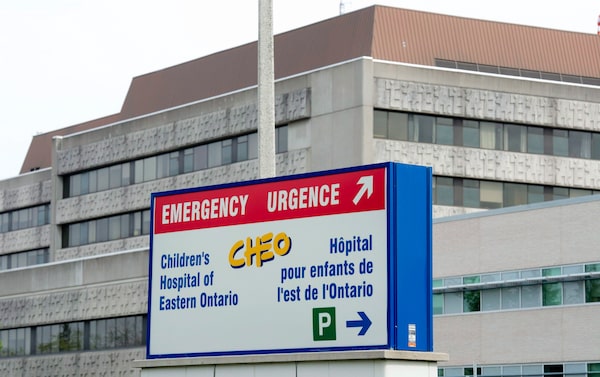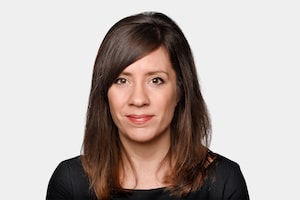
CHEO was operating at 134-per-cent capacity for inpatients as of Tuesday while the intensive care unit was at 129 per cent. The emergency department had 254 visits on Tuesday, despite the fact it was designed to see 150 patients a day.Adrian Wyld/The Canadian Press
Children’s hospitals across Canada are seeing an unusual surge in sick children needing medical attention for a variety of viruses and experts fear the problem will become more severe as COVID-19 cases rise and influenza season begins.
Some hospitals are reporting an alarming rise in pediatric hospital admissions for respiratory syncytial virus (RSV), a common illness that can lead to severe outcomes in a small percentage of those infected.
“This is an early surge,” Chuck Hui, chief of infectious disease, immunology and allergy at CHEO, a major pediatric hospital and research centre in Ottawa, said in a press briefing on Wednesday. “We’re seeing a significant number, increased number of RSV cases and also significant increase in RSV hospitalizations.”
The most recent respiratory virus report from the Public Health Agency of Canada confirms that RSV rates this year are above expected levels.
Some children’s pain relievers in short supply, say two Ontario hospitals
So far this month, CHEO has admitted 10 times the average number of patients for RSV it was seeing before the pandemic. The surge is adding to serious capacity problems, fuelling concern about how it and other health facilities will be able to meet the needs of pediatric patients this cold and flu season.
CHEO was operating at 134-per-cent capacity for inpatients as of Tuesday while the intensive care unit was at 129 per cent. The emergency department had 254 visits on Tuesday, despite the fact it was designed to see 150 patients a day.
“We are dealing now here at CHEO and at children’s hospitals across the country with an unprecedented surge in demand,” Alex Munter, president and CEO of CHEO, said during the briefing. “CHEO nor any of our organizations were built for this kind of demand.”
The period from May to September has been the busiest in CHEO’s nearly 50-year history, Mr. Munter said.
He said a lack of beds and staff has forced the hospital to cancel a handful of planned operations in recent days, including heart, brain and spine surgery. Postponed and cancelled surgeries are a major problem at pediatric facilities across Canada, with more than half of children and adolescents waiting beyond the recommended window for surgical procedures.
At McMaster Children’s Hospital in Hamilton, fewer than 10 children have RSV, but the emergency department is seeing “an unusually high seasonal surge in viral illnesses,” president Bruce Squires said in a statement.
Hospital officials are concerned about capacity in the months ahead and worry that the extreme pressure on health care staff “will not be sustainable if we see a major spike in illness,” Mr. Squires said in the statement.
Joan Robinson, a pediatric infectious disease physician at the Stollery Children’s Hospital in Edmonton, said all of these trends could make for a very challenging fall and winter.
“If we get flu, RSV and COVID admissions all at the same time, we could end up with really busy emergency departments and maybe not as much pediatric beds,” Dr. Robinson said.
According to CHEO, the increase in hospital admissions from RSV is likely because a cohort of children who had not previously had much exposure is now being introduced to this (and other viruses) all at once. And higher viral loads tend to lead to more severe cases. Since so many are infected, it could increase the chance that a child catches it from a few others, exposing them to a higher viral load.
Dr. Robinson said most parents don’t need to be overly alarmed about RSV this season. It’s a common virus that tends to infect all children by the time they turn 2. The most severe outcomes are typically seen in a small number of children during their first encounter with the virus, she said. About 70 per cent of children under age 2 will have cold-like symptoms when infected with RSV, but about 30 per cent will develop bronchiolitis. Of those, about 1 or 2 per cent will require hospital admission, Dr. Robinson said.
Melissa Langevin, associate medical director of emergency medicine at CHEO, said there are some key signs parents and caregivers need to watch for and seek medical attention if they appear:
- pauses in breathing and/or fever in a child under 2 months
- signs of difficulty breathing, including pulling in at the ribcage or neck.
- a significant reduction in fluid intake
- unusual sleepiness in a child without a fever
Parents should use nasal aspirators or “snot suckers” in children under 6 months to clear their noses and help them breathe, Dr. Langevin said. RSV tends to last for about a week and peaks on days four and five, she said, and is often accompanied by a cough. Children under age 6 should not take over-the-counter cough and cold medicine.
 Carly Weeks
Carly Weeks